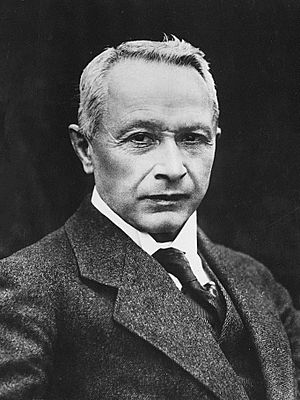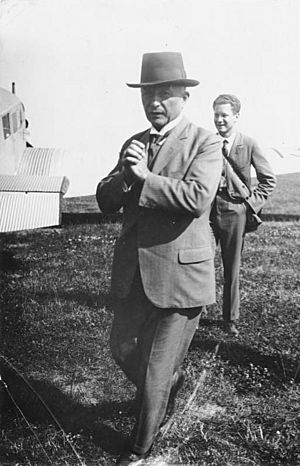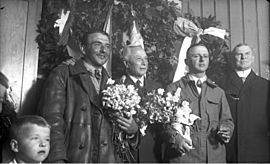Hugo Junkers facts for kids
Quick facts for kids
Hugo Junkers
|
|
|---|---|

Junkers in 1920
|
|
| Born | 3 February 1859 Rheydt, Rhine Province, Kingdom of Prussia
|
| Died | 3 February 1935 (aged 76) |
| Resting place | Munich Waldfriedhof |
| Education | Royal Polytechnic University in Charlottenburg Royal Technical University in Aachen |
| Occupation | Engineer |
| Spouse(s) | Therese Ida Bennhold |
| Children |
|
| Parent(s) |
|
Hugo Junkers (born February 3, 1859 – died February 3, 1935) was a brilliant German engineer and aircraft designer. He was a pioneer in creating airplanes made entirely of metal. He also worked on flying wing designs.
His company, Junkers Aircraft and Motor Works, was very important in the German aircraft industry. This was especially true between World War I and World War II. His metal passenger and cargo planes helped start airlines all over the world.
Besides aircraft, Junkers also built diesel and petrol engines. He held many patents related to heat and metals. He also supported the Bauhaus art and design movement. He helped the Bauhaus school move to Dessau in 1925, where his factory was located.
Some of his most famous creations include:
- The Junkers J 1 (1915): The world's first practical all-metal aircraft. It had a special wing design with almost no outside supports.
- The Junkers F 13 (1919): The world's first all-metal passenger airplane.
- The Junkers W 33: This plane made the first successful flight across the Atlantic Ocean from east to west.
- The Junkers G.38: A large "flying wing" design.
- The Junkers Ju 52: Nicknamed "Tante Ju" (Aunt Ju), it was one of the most famous airliners of the 1930s.
In 1933, the new German government asked Junkers to help with their military plans. When he said no, they took control of his companies and patents. Hugo Junkers was placed under house arrest in 1934. He passed away in 1935. After his death, his company made many successful German warplanes for World War II.
Who Was Hugo Junkers?
Hugo Junkers was born in Rheydt, a town in what was then the Kingdom of Prussia. His father was a rich factory owner. After finishing school in 1878, Hugo studied engineering. He went to the Royal Polytechnic University in Charlottenburg and the Royal Technical University in Aachen. He finished his studies in 1883.
At first, he worked for his father's company. But soon, he studied more about electricity and heat. He then worked on developing the first opposed-piston engine. To measure how much heat things produced, Junkers invented a special device called a calorimeter. He started a company in 1892 to make these.
Junkers showed his calorimeter at the 1893 World's Columbian Exposition in Chicago. It won a gold medal there. The next year, he invented a gas-powered bath boiler. He later improved this into a tankless water heater. In 1895, he started his company, Junkers & Co., to use his inventions.
From 1897, he became a professor of mechanical engineering in Aachen. He taught there until 1912. While teaching, Junkers also worked as an engineer. His company, Junkers & Co., grew by making and selling calorimeters, gas stoves, pressure regulators, and other inventions.
Building Amazing Airplanes
Hugo Junkers started his serious work on airplanes when he was 50 years old. He worked with engineer Hans Reissner in Aachen. Reissner had started building an all-metal aircraft in 1909. Junkers & Co. built the corrugated iron wings for this plane. These special wings were patented a year later. Junkers also built a wind tunnel and invented a hydraulic brake.
He had big ideas for metal airplanes and flying wings. But World War I forced him to focus on making aircraft for the government. In 1915, he created the Junkers J 1. This was the world's first practical all-metal aircraft design. It was nicknamed "Blechesel," meaning "Sheetmetal Donkey." A piece of this plane was displayed in a museum until World War II.
His company's first military plane was the Junkers J.I (1916–17). It was a two-seat, all-metal plane with armor around the engine, pilot, and observer. It was considered the best German ground attack aircraft of the war. In 1917, the German government made him combine his company with Anthony Fokker's. They formed Junkers-Fokker Aktiengesellschaft.
By 1918, Junkers' company made the world's first low-winged, single-seat, all-metal fighter plane, the Junkers D.I. This plane used a new light metal called duralumin. He also made a two-seat monoplane fighter, the Junkers CL.I. Later, famous aircraft designers like Andrei Tupolev from Russia and William Bushnell Stout from America learned a lot from Junkers' ideas. They used his method of building planes with corrugated, light metal.
After World War I, the Junkers F.13 (1919) was the first of many successful civilian aircraft from Junkers. Later, he designed the Junkers Ju 52/3m in 1932. Hugo Junkers also helped start and grow airlines around the world. He wanted to sell them his aircraft. He played a key role in the early days of airlines like Deutsche Luft Hansa and Lloyd Aéreo Boliviano.
Many of his business ideas faced problems due to economic or political issues. But Junkers always had new ideas. For example, his huge four-engined G.38 plane, nicknamed "Der Grosse Dessauer," was often recalled to the factory for improvements.
Hugo Junkers' Legacy
Hugo Junkers is best known for the aircraft that carry his name. This includes planes he designed for the German Empire during World War I. It also includes the civilian aircraft made by Junkers Aircraft Works between the World Wars. Hugo Junkers passed away in 1935, on his 76th birthday.
After World War I, the first all-metal aircraft designs by Andrei Tupolev (like his Tupolev ANT-2 in 1924) and William Bushnell Stout (like his Stout ST in 1922) were inspired by Junkers' work. Both engineers used Junkers' ideas to build their own planes. Tupolev later built the massive, eight-engined Maksim Gorki, which was the largest aircraft in the world in the early 1930s. Stout created the popular Ford Trimotor airliner.
In 1976, Hugo Junkers was honored by being added to the International Air & Space Hall of Fame.
Timeline
- 1888–1893: Works with Dessauer Continental-Gasgesellschaft.
- 1892: Patents his calorie meter.
- 1895: Founds Junkers & Co in Dessau to build gas engines and heaters.
- 1897–1912: Becomes a professor at the RWTH Aachen University in Aachen.
- 1908: Helps Hans Reissner start work on all-metal aircraft.
- 1910: Patents the idea of carrying passengers inside the wing.
- 1913/14: Uses a wind tunnel for testing.
- 1915: The Junkers J 1 all-metal monoplane flies. It is the world's first practical all-metal aircraft.
- 1916: The Junkers J 2, an all-metal fighter aircraft, is built for the German air force.
- 1917–1919: Forms a partnership called Junkers-Fokkerwerke AG. They mass-produce 227 J4 aircraft.
- 1919: Junkers and Fokker separate. The company is renamed Junkers Flugzeugwerke AG.
- 1919: The first civilian all-metal aircraft, the Junkers F.13, flies.
- 1919: Starts work on the "Giant" JG1, designed to seat passengers inside its thick wings.
- 1921: The JG1 is ordered to be destroyed because it is too big for post-war rules.
- 1921: Founds "Abteilung Luftverkehr der Junkerswerke," which later joins Deutsche Luft Hansa.
- 1922: Starts making military aircraft near Moscow, with German government loans.
- 1922: Proposes a 100-passenger J-1000 aircraft, but it is never built.
- 1925: The Russian project fails, and the German government demands money back.
- 1926: Legal battles end with Junkers losing several companies.
- 1927: Receives the Wilhelm Exner Medal for his work.
- 1928: A Junkers W33 makes the first east-west transatlantic flight by a heavier-than-air aircraft.
- 1930: Receives the Siemens-Ring for his scientific work on engines and metal airplanes.
- 1931: The Junkers G38, a 34-passenger airliner, is delivered. It is the largest in the world until 1934. Only two are built.
- 1932: After a big economic crash, he saves his aircraft and engine companies from bankruptcy by selling almost all his other assets.
- 1935: Dies during talks to give up his remaining shares and interests in Junkers.
- 1935: Therese Junkers, his wife, gives full control of his interests to the Third Reich.
See also
 In Spanish: Hugo Junkers para niños
In Spanish: Hugo Junkers para niños



